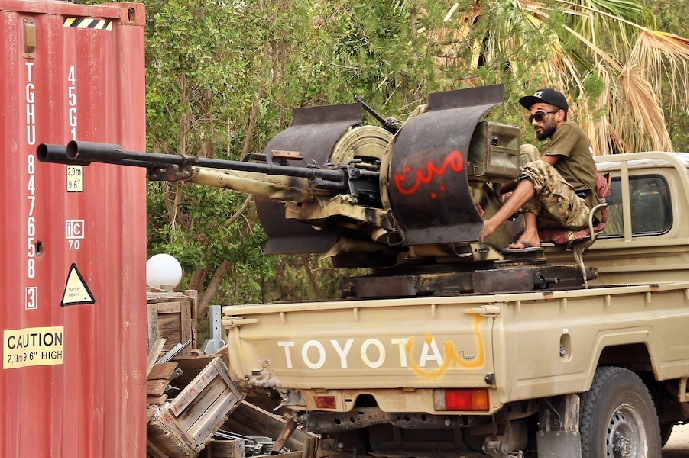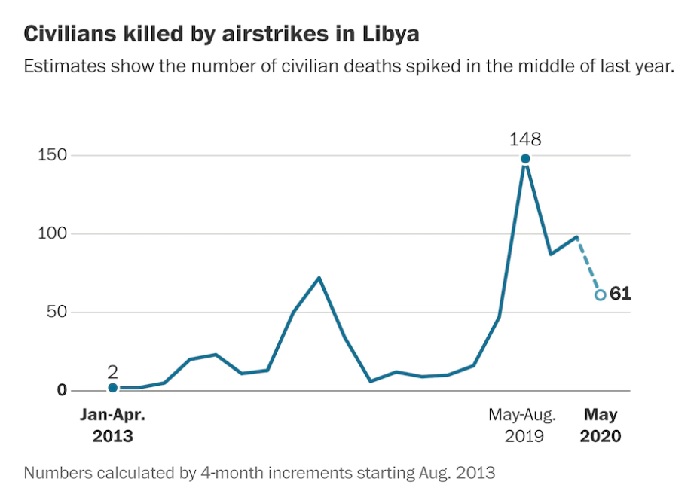
Reported civilian casualties in Libya have surged over the past year amid a prolonged battle for the capital, Tripoli, with forces believed to be linked to a warlord based in the eastern part of the country responsible for most noncombatant deaths, a study found.
The analysis by the New America Foundation and Airwars, which tracks allegations of civilian deaths, showed that forces associated with military leader Khalifa Hifter were believed to be responsible for the majority of reported casualties.
Airstrikes and alleged civilian deaths have increased dramatically since Hifter’s Libyan National Army (LNA) launched an ongoing operation to take Tripoli in April 2019 from the U.N.-backed Government of National Accord (GNA), the analysis found.
According to Airwars, at least 429 of the estimated minimum of 727 civilian deaths in Libya since 2012, or about 60 percent, are believed to have taken place since the offensive began. Airwars assigned responsibility to Hifter’s group or affiliated forces for at least 270 of the deaths since the start of the Tripoli battle while saying the GNA and affiliated forces were believed to be responsible for 95.
In its report titled “Airstrikes, Proxy Warfare and Civilian Casualties,” an advance copy of which was obtained by The Washington Post, New America found that most of the strikes conducted in Libya since 2019 have been concentrated around Tripoli, a change from previous years when they mostly targeted areas populated by suspected Islamist extremists including Benghazi, Derna and Sirte.

The shifting nature of the Libyan conflict is another illustration of the failed promise of Libya’s 2011 revolution, when many Libyans hoped that the ouster of longtime authoritarian Moammar Gaddafi would yield openness, stability and prosperity.
Instead, the country descended into a tangled civil conflict in which competing administrations in the east and west claim legitimacy as they vie for control of oil and other resources. The strife has allowed criminal networks to prey on migrants and extremist groups to flourish, as took place when the Islamic State established one of its most organized and brutal affiliates in 2015.
All told, there have been more than 4,000 airstrikes by all parties since 2012, the report found. On Sunday, five people were reported to have died after an artillery strike on a Tripoli park, Reuters reported.
On Tuesday, the United Nations said the GNA and LNA had agreed to resume cease-fire talks to end the fighting. Previous efforts to secure a lasting cease-fire have been unsuccessful.
The LNA did not provide an immediate comment on the report’s assertions.
In a message, Mohammed Ali Abdallah, senior adviser to the GNA for U.S. affairs, characterized Hifter as the driver of the current conflict and said GNA military operations were defensive in nature. He said any alleged violations by GNA or affiliated forces were investigated.
“The false equivalency that sometimes is reflected in political statements, condemnations, and even in some reports, attempts to pin the behavior of a military outlaw up against the military action taken by our government in an attempt to protect Libyans & Libyan institutions,” he said.
The conflict has also given rise to an increasingly complex competition between countries with perceived interests in Libya, pulling in an array of nations that have provided military and other support — usually behind the scenes — to both sides despite a United Nations arms embargo. According to New America and Airwars, at least seven countries have conducted airstrikes in Libya since 2012.
Foreign supporters to Hifter’s faction are believed to include Russia, the United Arab Emirates, Egypt and Saudi Arabia, emboldening the LNA to seek a military victory.
“Hiftar’s ability to attract foreign backing has amplified the LNA’s military capabilities,” the report said, using an alternate spelling.
Last week, U.S. Africa Command took the unusual step of publicly condemning the Russian government for allegedly sending advanced fighter jets to Libya to assist the LNA. U.S. officials have also linked the Russian government to the presence alongside the LNA of fighters for the Wagner Group, a private army. Russian officials denied the charge.
Foreign support to the U.N.-backed government, the GNA, meanwhile is believed to have increased this year as Turkey began openly providing fighters and aiding in an attempt to stave off an LNA capture of Tripoli. Both sides employ paid fighters from a number of countries, including Syria.
In another example of the murky nature of the war, The Washington Post last year reported that a U.S. Air Force veteran apparently working as a contractor for the GNA was captured by the LNA and held for six weeks in 2019 before being released.
Identifying responsibility for individual airstrikes is difficult in Libya given that many countries do not publicly acknowledge their roles in the conflict, but researchers say they attempt to do so by using information that includes the target and the kind of weapon or aircraft involved.
While Libyan combatants have had access to aircraft from Gaddafi’s aging fleet, it’s not clear how much of that remains after years of fighting. The UAE, for example, is believed to have provided Chinese-made drones, while Turkey is believed to have provided Turkish-made drones.
The report cites an unnamed Turkish government official who said that Turkish personnel have been sent to Libya to train and advise GNA forces but denied that Turkey is directly conducting military strikes. The report also identifies a surge in strikes in 2019 attributed to the United Arab Emirates. Authorities from that country declined to comment.
A recent U.N. report likewise warned of continued civilian harm as a result of every category of armed activity, documenting at least 64 noncombatant deaths in the first three months of this year. The United Nations blamed the LNA for 81 percent of those casualties.
While President Barack Obama’s administration backed the NATO-led intervention in 2011, Libya has not ranked among top U.S. foreign policy priorities in the years since.
New America and Airwars found that the U.S. role in alleged civilian casualties since 2012 has been relatively small despite a major military operation conducted in 2016 against Islamic State fighters in the coastal city of Sirte.
According to estimates in the report, the United States conducted 550 strikes between 2012 and February 2020, mostly targeting the Islamic State, which Airwars and New America reported killed at least 11 civilians.
Col. Christopher Karns, a spokesman for U.S. Africa Command (AFRICOM), said that U.S. military operations had resulted in a dramatic reduction in the Islamic State presence in Libya. He said AFRICOM had investigated six allegations of civilian casualties and found them to be unsubstantiated. The command has not acknowledged any civilian casualties in Libya.
“While surgical-like precision is always the aim, if a mistake happens we’ll admit and own it,” he said.
Karns said the presence of aircraft and private military personnel from Russia contributed to the dangers facing civilians. “Lesser-trained, non-state actors not bound by traditional laws of armed conflict should be a concern to everyone,” he said.
